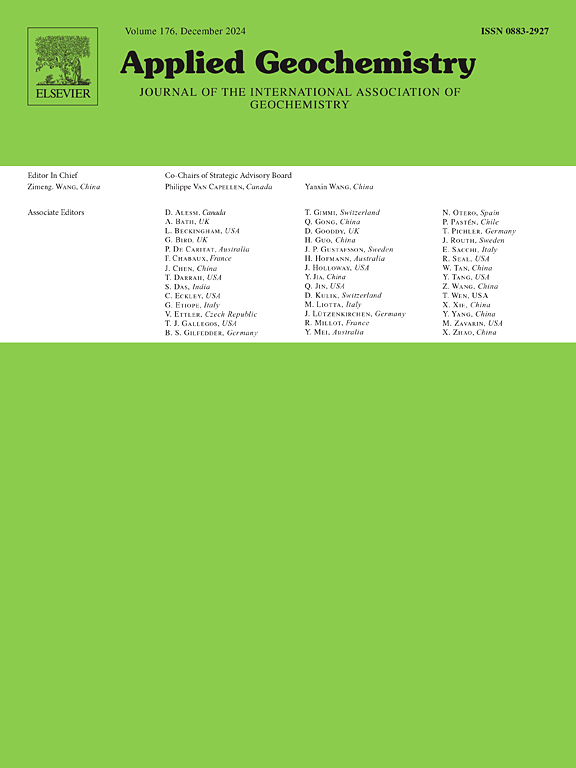Effect of cellulose degradation products on 63Ni sorption on Portland cement
IF 3.1
3区 地球科学
Q1 GEOCHEMISTRY & GEOPHYSICS
引用次数: 0
Abstract
Concepts of nuclear waste repositories make use of large quantities of cementitious materials, especially near surface disposal facilities in which cement, mortar, and concrete are used both as structural materials and waste immobilization matrices. The retardation of radionuclides by the cementitious barriers of these repositories is crucial for the safe long-term management of the waste. Yet both the degradation of the cementitious materials and the presence of complexing ligands originating from the waste can affect the sorption of radionuclides. Cellulosic materials present in nuclear waste degrade under irradiation and under the alkaline conditions generated by the cementitious materials and they release organic compounds. Within the cellulose degradation products, α-isosacharinic acid (α-ISA) is generally assumed to be the strongest radionuclide complexant and to have the most impact on radionuclide sorption, though the presence of other ligands in the mixture could also have an effect. In this work, the sorption of 63Ni was assessed on fresh and state III hardened cement paste (HCP). The effect of α-ISA on the 63Ni sorption at these two degradation states was investigated and compared to the effect of a complete mixture of cellulose degradation products generated by irradiation and alkaline degradation of cellulosic tissues. A higher sorption of 63Ni was observed on state III HCP (Rd = (8.6 ± 3.3) × 103 L/kg) than on fresh HCP (Rd = (1.0 ± 0.3) × 103 L/kg), and, in both cases, the sorption was higher than previously observed on pure C–S–H (calcium silicate hydrate) suggesting the involvement of other mechanisms than the sole surface complexation on C–S–H. The effect of α-ISA on the sorption of 63Ni depended on the cement degradation state, ranging from no effect on fresh cement to a maximal sorption reduction factor of 8 ± 3 on degraded cement for 10−2 M α-ISA. The effect of the mixture of degradation products from cellulosic tissues on the sorption of 63Ni was found to be considerably higher on both fresh and degraded HCP, with a sorption reduction factor of 582 ± 972 and 718 ± 327 for the fresh and degraded cement, respectively, for a corresponding α-ISA concentration of 10−2 M.
纤维素降解产物对硅酸盐水泥吸附63Ni的影响
核废料储存库的概念利用了大量胶凝材料,特别是近地面处置设施,其中水泥、砂浆和混凝土既用作结构材料,又用作废物固定基质。这些储存库的胶凝屏障对放射性核素的阻滞对废物的长期安全管理至关重要。然而,胶凝材料的降解和源自废物的络合配体的存在都会影响放射性核素的吸收。核废料中的纤维素材料在辐照和胶凝材料产生的碱性条件下降解,并释放出有机化合物。在纤维素降解产物中,α-异糖精酸(α-ISA)通常被认为是最强的放射性核素络合剂,对放射性核素吸附的影响最大,尽管混合物中其他配体的存在也可能有影响。在这项工作中,评估了新鲜和状态III硬化水泥浆(HCP)对63Ni的吸附。研究了α-ISA在这两种降解状态下对63Ni吸附的影响,并与纤维素组织经辐照和碱性降解产生的纤维素降解产物完全混合的效果进行了比较。在III态HCP (Rd =(8.6±3.3)× 103 L/kg)上观察到63Ni的吸附量高于新鲜HCP (Rd =(1.0±0.3)× 103 L/kg),并且在这两种情况下,吸附量都高于之前在纯C-S-H(水合硅酸钙)上观察到的吸附量,这表明除了C-S-H的表面络合作用外,还涉及其他机制。α-ISA对63Ni吸附的影响取决于水泥的降解状态,α-ISA在10−2 M时对新鲜水泥无影响,对降解水泥的最大吸附还原因子为8±3。结果表明,当α-ISA浓度为10−2 M时,新鲜水泥和降解水泥对63Ni的吸附还原系数分别为582±972和718±327。
本文章由计算机程序翻译,如有差异,请以英文原文为准。
求助全文
约1分钟内获得全文
求助全文
来源期刊

Applied Geochemistry
地学-地球化学与地球物理
CiteScore
6.10
自引率
8.80%
发文量
272
审稿时长
65 days
期刊介绍:
Applied Geochemistry is an international journal devoted to publication of original research papers, rapid research communications and selected review papers in geochemistry and urban geochemistry which have some practical application to an aspect of human endeavour, such as the preservation of the environment, health, waste disposal and the search for resources. Papers on applications of inorganic, organic and isotope geochemistry and geochemical processes are therefore welcome provided they meet the main criterion. Spatial and temporal monitoring case studies are only of interest to our international readership if they present new ideas of broad application.
Topics covered include: (1) Environmental geochemistry (including natural and anthropogenic aspects, and protection and remediation strategies); (2) Hydrogeochemistry (surface and groundwater); (3) Medical (urban) geochemistry; (4) The search for energy resources (in particular unconventional oil and gas or emerging metal resources); (5) Energy exploitation (in particular geothermal energy and CCS); (6) Upgrading of energy and mineral resources where there is a direct geochemical application; and (7) Waste disposal, including nuclear waste disposal.
 求助内容:
求助内容: 应助结果提醒方式:
应助结果提醒方式:


